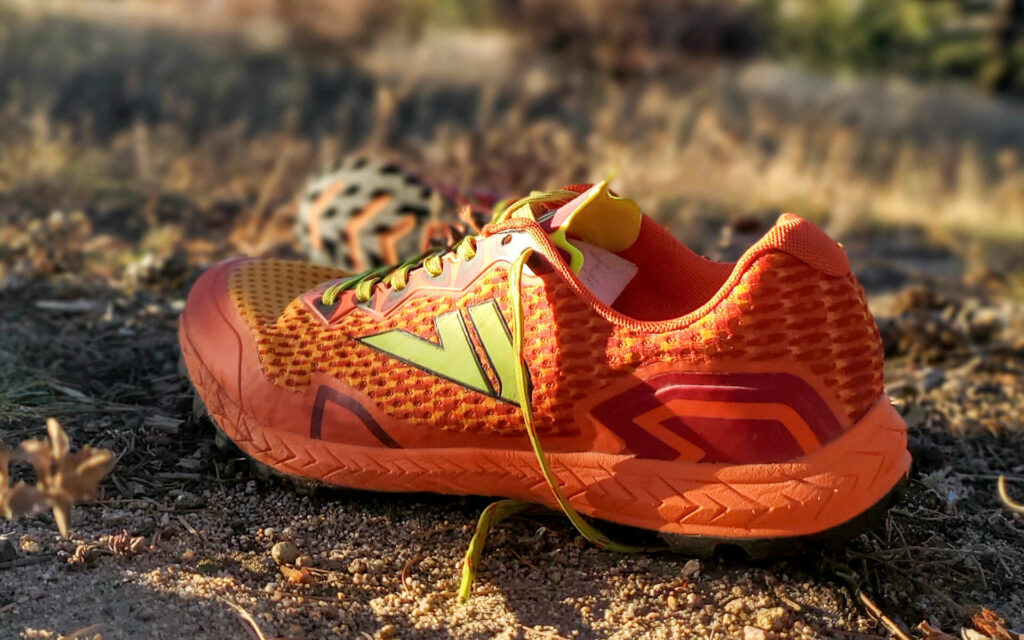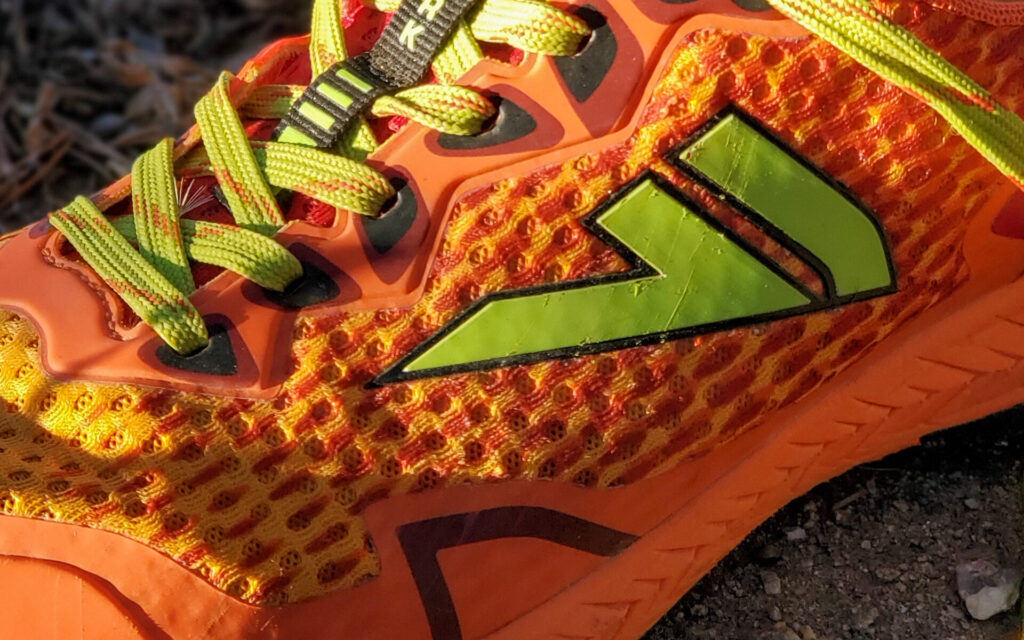
TAYLOR: We’re not strangers to the originally Finnish company anymore. This small-name brand (in the US at least) is starting to make some waves around the world with top-level mountain/trail athletes crushing in their shoes. British athlete Jon Albon is a particularly good example of this with a most recent win at the OCC as part of the UTMB parade of races. Many seem to dismiss these as simply an Obstacle Course Racing brand, but VJ continues to prove its prowess on various terrain.
VJ was birthed with purpose. Those standards carry through to their newest offering, the Spark. In general, you’ll be sure to get durability, extreme grip, and a lightweight package from VJ. The Spark takes that to the next level as one of the more minimalistic shoes in their lineup. Does it have enough to shred the trails like its more cushioned cousins, the MAXx and Ultra? Or is it simply a lightweight, soft-ground, OCR shoe?

TAYLOR: Grip is absolutely a reason you would be looking at VJ shoes. The Spark carries the torch with their proud hashtag on it: #bestgripontheplanet. It’s not just a self-made slogan for selling purposes or bragging. It’s just the truth!
The outsole is full of deep five-millimeter claw-like multidirectional lugs. You usually won’t see something past a three-millimeter depth for a shoe in this weight class, even with Inov-8, a similarly branded more well-known company. So, that’s impressive in its own right. These are not ordinary rubber lugs, though. These are butyl rubber lugs. In other words, they are extreme in the grip and durability department and, dare I say, almost too grippy at times. They handled everything I threw at them, from steep technical terrain to wet granite. This outsole reins supreme.
Working up from ground level, the next layer is a dense layer of EVA. It’s a thin, flexible, and surprisingly protective layer. The total stack is 27mm in the heel to 22mm in the forefoot. It’s not much at all, especially with no rockplate, but I felt that I had a good sense of ground feel and protection at the same time. The butyl rubber outsole definitely had something to do with that protection. After digging a little more, I found that butyl rubber is also great at absorbing shock. Dual purposes going on here? I’m thinking definitely.
Durability is a recurring theme with VJ. Though the upper here is not the typical kevlar blend of fibers, it still will handle nearly any condition and terrain. A breathable nylon mesh gives the Spark a light feel as compared to their other offerings. It provides a more flexible experience than the others yet is still noticeably rigid throughout. Welded overlays run nearly 360 degrees around the base of the upper. Special attention is put around the already reinforced toe cap to save those little tootsies in the inevitable case of a little toe-smash on the way down the mountain.

For what it’s worth, I could imagine these being durable enough to rack up tons of miles without much change in the shoe.
As for fit, these are noticeably narrow. I was surprised, however, about how comfortable the forefoot was. Even with having a reasonably sensitive bunion on one foot, I never felt pressure up front. I had the freedom to dance among the rocks without pain or restriction. As always, the Fitlock system and semi-gusseted tongue held the midfoot in place nicely too. Also the heel locked in securely, too — better than any VJ shoe I have worn. Full disclosure, I did have a little slippage (as with all VJ shoes so far) until I changed the lacing by utilizing the other eyelets and weaving differently from their standard.
When the complete package is considered, I loved the VJ Spark for these fall months where any trail condition is possible (and probable). They are very lightweight (9.4 ounces for a men’s 10.5), nimble, fit nicely, and are durable enough to handle just about anything. I especially loved uphill running in these and can foresee them taking part in some summit assaults in the near future.
All of these positives brought me to the conclusion that the VJ Spark reminds me of a mix between some of our favorite trail shoes of all time, the Inov-8 Terraultra G 270, VJ Ultra, Merrell Skyfire, and Adidas Terrex Ultra Speed. The main differences being that the Spark is lighter, more firm, aggressive, and has some drop to boot (compared to the zero drop Terra Ultra). I’m not necessarily saying the Spark is BIG award-worthy, but it is worth noting though!
Shop VJ Spark
TAYLOR: Technical prowess is a beautiful thing in these lightweight shoes, but there are certainly limitations here. Many of its inadequacies were highlighted on technical and/or downhill terrain.
One, of course, is limited protection. Yes, these do have a good amount for how minimal a shoe they are, but technical terrain became a little bit of a worry. The flats and uphills were fine, but I needed to be a lot more choosey with footing on the downhills than I would like. Rocks and roots were a lot more bothersome and I was not able to commit to the trail as much like when wearing something like Topo Athletic MTN Racer 2 or ASICS Fuji-Lyte 2. This is one of the few occasions I actually wish for a forefoot rock plate or added mesh layer. It’d be a simple way to maintain the integrity and positives of the shoe while giving it more range.
Downhills were also quite a bit iffier because of the very slim heel. Flip over the Spark, and you’ll first notice its standard-setting outsole. Then you’ll notice the heel and midfoot width looks like someone who took their Beach Body meal replacements a little too seriously. These are terribly slim! Again, this didn’t seem to have much of an effect on uphills or flats, but when speeding up or hitting technical downhills the Spark drove like Bo Duke. They were pretty squirrely on uneven terrain. This is a neutral trail shoe, but it is very unstable when speed and technicality is added. I could never fully commit to slamming downhills like I typically would. On many accounts, I would consider this shoe for racing on technical terrain BUT (if you can’t tell this is a big but) this point alone would probably prevent me from cashing in on it. The downhill is something I want to be confident on when going fast — that is where the Merrell MTL Skyfire really got it right.
Also, similar to the Ultra, I found that the Spark does not run particularly well on flat ground. It just doesn’t have a smooth enough transition. It’s certainly meant for having dirt underfoot.
Shop VJ Spark
TAYLOR: VJ’s newest trail / OCT addition will undoubtedly start a fire in you to want to go fast. The Spark is a light and nimble trail shoe with all the equipment needed to hammer for shorter, faster outings. The butyl rubber outsole is a standout with deep lugs sets a huge precedence for security in all conditions. The rest of the package is also durable and capable to hang along for the ride…except when slamming downhills. Overall, the ride is a little too squirrely and not quite protective enough to commit fully to a screaming descent.
On the other hand, the Spark is an absolute monster for uphill grinding. I guess you win some and lose some with this one. Check out the VJ Spark on VJ’s website for $150.
Shop VJ SparkHave something to say? Leave a Comment

